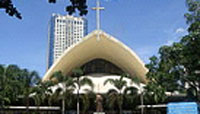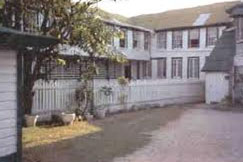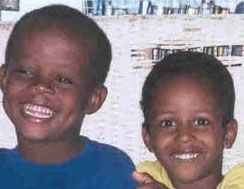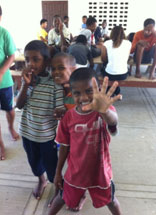THE Roman Catholic Church has indisputably been embroiled in some serious scandals during the centuries of its existence; but while these should be ventilated and addressed, these anomalies should not shape the identity of the whole, and equally indisputable are the uncountable, priceless and great works done to serve humanity by that body’s monks, priests and nuns worldwide.
 Most notably among them, latterly, being saintly Mother Teresa, who administered to the vulnerable, needy, sick and destitute all her life, under the direst situations, and the works of St. John Bosco was another shining example of the contribution of the Roman Catholic Church to the upliftment of mankind.
Most notably among them, latterly, being saintly Mother Teresa, who administered to the vulnerable, needy, sick and destitute all her life, under the direst situations, and the works of St. John Bosco was another shining example of the contribution of the Roman Catholic Church to the upliftment of mankind.
The Bosco orphanage in Guyana has nurtured many children who would otherwise have been left on the dungheap of life, and this amazing institution owes its genesis to one amazing man – veritably one of God’s chosen.
GENESIS OF THE BOSCO ORPHANAGE
John Bosco (Italian: Giovanni) was born in the evening of 16 August 1815 in Becchi, Italy. He was the youngest son of Francesco Bosco (1784–1817) and Margherita Occhiena. He had two elder brothers, Antonio and Giuseppe (1813–1862).
The Boscos of Becchi were farmhands of the Moglia Family. John Bosco was born into a time of great shortage and famine in the Piedmontese countryside, following the devastation wrought by the Napoleonic wars and a drought in 1817.
As in the case of most great men who have made meaningful contribution to the world, Bosco’s mother, Margherita, played a strong role in his formation and personality, and was an early supporter of her son’s ideals. When he was young, he would put on shows of his skills as a juggler, magician and acrobat with prayers before and after the performance.
A LIFE-CHANGING DREAM
 In 1825, when he was nine, Bosco had the first of a series of dreams which would play an influential role in his outlook and work. This first dream “left a profound impression on him for the rest of his life”, according to his own memoirs.
In 1825, when he was nine, Bosco had the first of a series of dreams which would play an influential role in his outlook and work. This first dream “left a profound impression on him for the rest of his life”, according to his own memoirs.
Bosco apparently saw a man, who “appeared, nobly attired, with a manly and imposing bearing”. The man said to him: “You will have to win these friends of yours, not with blows, but with gentleness and kindness. So begin right now to show them that sin is ugly and virtue beautiful.”
Poverty prevented any serious attempt at schooling. Nevertheless it is suggested that the idea to become a priest came from his childhood experiences.
At the time, being a priest was generally seen as a profession for the privileged classes, rather than farmers, although it was not unknown. Some biographers portray his brother Antonio as the main obstacle for Bosco’s ambition to study, protesting that John was just “a farmer like us!” Nevertheless, Margaret gave her support to John and he finally left home in February 1828 at the age of twelve.
POVERTY NO DETERRENT TO ACHIEVEMENT
 Having to face life by himself at such a young age may have developed his later sympathies to help abandoned boys. After begging unsuccessfully for work, Bosco ended up at the wine farm of Louis Moglia. However, although Bosco could pursue some studies by himself, he was unable to attend school for two more years.
Having to face life by himself at such a young age may have developed his later sympathies to help abandoned boys. After begging unsuccessfully for work, Bosco ended up at the wine farm of Louis Moglia. However, although Bosco could pursue some studies by himself, he was unable to attend school for two more years.
In 1830 he met Joseph Cafasso, an elderly priest who identified some natural talent and supported his first schooling. From there-on his rise to greatness was meteoric.
He is described as an Italian Roman Catholic priest, educator and writer of the 19th century, who put into practice the convictions of his religion, dedicating his life to the betterment and education of street children, juvenile delinquents, and other disadvantaged youth and employing teaching methods based on love rather than punishment, a method known as the Salesian Preventive System. A follower of the spirituality and philosophy of Saint Francis de Sales, Bosco dedicated his works to him when he founded the Salesians of Don Bosco. Together with Maria Domenica Mazzarello, he founded the Institute of the Daughters of Mary Help of Christians, a religious congregation of nuns dedicated to the care and education of poor girls. In 1876, Bosco founded a movement of laity, the Association of Salesian Cooperators, with the same educational mission to the poor. In 1875, he published the Salesian Bulletin, which remains in continuous publication, and is currently published in 50 different editions and 30 languages.
In 1876, Bosco founded a movement of laity, the Association of Salesian Cooperators, with the same educational mission to the poor. In 1875, he published the Salesian Bulletin, which remains in continuous publication, and is currently published in 50 different editions and 30 languages.
NETWORKING CHARITY
Bosco established a network of organizations and centres to carry on his work. Following his beatification in 1929, he was canonized as a saint in the Roman Catholic Church by Pope Pius XI in 1934.
Road to ‘Bosco’ strewn with thorns John Bosco discovered along the way that his passion for helping others did not automatically make his efforts acceptable and supported; but instead he was subjected to suspicion and castigation.
John Bosco discovered along the way that his passion for helping others did not automatically make his efforts acceptable and supported; but instead he was subjected to suspicion and castigation.
He began as the chaplain of the Rifugio (‘Refuge’), a girls’ boarding school founded in Turin by the Marchioness Giulia di Barolo, but he had many ministries on the side such as visiting prisoners, teaching catechism and helping out at country parishes.
A growing group of boys would come to Rifugio on Sundays and feast days to play and learn their catechism. They were too old to join the younger children in regular catechism classes in the parishes. This was the beginning of the “Oratory of St. Francis de Sales”. Bosco and his oratory moved around town for a number of years and were turned out of several places in succession.
After only two months based in the church of St. Martin, the entire neighborhood expressed its annoyance with the noise coming from the boys at play. A formal complaint was lodged against them with the municipality. Rumors also circulated that the meetings conducted by the priest with his boys were dangerous; their recreation could be turned into a revolution against the government. This ensued in the group bring evicted.
MOTHER GREATEST HELP In 1846, Bosco rented a shed in the new Valdocco neighborhood on the north end of town from Mr. Pinardi. This served as the oratory’s new home. His mother moved in with him and in 1844, he and “Mamma Margherita” began taking in orphans.
In 1846, Bosco rented a shed in the new Valdocco neighborhood on the north end of town from Mr. Pinardi. This served as the oratory’s new home. His mother moved in with him and in 1844, he and “Mamma Margherita” began taking in orphans.
Bosco also had the help of several friends at the oratory. One influential friend was the Piedmontese Justice Minister Urbano Rattazzi who, despite being anticlerical, nevertheless saw some value in Bosco’s work so, while he was pushing a bill through the Sardinian legislature to suppress religious orders, he conversely simultaneously advised Bosco on how to get around the law and found a religious order to keep the oratory going after its founder’s death.
Opposition to Bosco and his work came from various quarters. Traditionalist clergy accused him of stealing a lot of young and old people away from their own parishes. Nationalist politicians (including some clergy) saw his several hundred young men as a recruiting ground for revolution. The Marquis de Cavour, chief of police in Turin, regarded the open-air catechisms as overtly political and a threat to the State, and was highly suspicious of Bosco’s support for the powers of the papacy. Bosco was interrogated on several occasions, but no charges made. Closure may have been prevented by orders from the king that Bosco was not to be disturbed. Several attempts were also made on Bosco’s life, including a near-stabbing, bludgeoning and a shooting.
VOLUNTEERISM & LOVE Bosco’s capability to attract numerous boys and adult helpers was connected to his “Preventive System of Education”. He believed education to be a “matter of the heart” and said that the boys must not only be loved, but know that they are loved. He also pointed to three components of the Preventive System: reason, religion and kindness. Music and games also went into the mix.
Bosco’s capability to attract numerous boys and adult helpers was connected to his “Preventive System of Education”. He believed education to be a “matter of the heart” and said that the boys must not only be loved, but know that they are loved. He also pointed to three components of the Preventive System: reason, religion and kindness. Music and games also went into the mix.
DEATH AND LEGACY
Bosco died on 31 January, 1888. His funeral was attended by thousands. Soon after there was popular demand to have him canonized. The Archdiocese of Turin investigated and witnesses were called to determine if Bosco was worthy to be declared a saint. The Salesians, Daughters and Cooperators gave supportive testimonies. But many remembered Bosco’s controversies in the 1870s with Archbishop Gastaldi and some others high in the Church hierarchy thought him a loose cannon and a “wheeler-dealer”. In the canonization process, testimony was heard about how he went around Gastaldi to get some of his men ordained and about their lack of academic preparation and ecclesiastical decorum. Political cartoons from the 1860s and later showed him shaking money from the pockets of old ladies or going off to America for the same purpose. These cartoons were not forgotten. Opponents of Bosco, including some cardinals, were in a position to block his canonization and many Salesians feared around 1925 that they would succeed.
In the canonization process, testimony was heard about how he went around Gastaldi to get some of his men ordained and about their lack of academic preparation and ecclesiastical decorum. Political cartoons from the 1860s and later showed him shaking money from the pockets of old ladies or going off to America for the same purpose. These cartoons were not forgotten. Opponents of Bosco, including some cardinals, were in a position to block his canonization and many Salesians feared around 1925 that they would succeed.
Pope Pius XI had known Bosco and pushed the cause forward. Bosco was declared blessed in 1929 and canonized on Easter Sunday of 1934, when he was given the title of “Father and Teacher of Youth”.
Bosco’s work was carried on by his early pupil, collaborator and companion, Michael Rua, who was appointed rector major of the Salesian Society by Pope Leo XIII in 1888.
St John Bosco orphanage established in Guyana
 |
 |
Happy faces of children reflect the love and care they receive from their caregivers |
At a time when survival was difficult in 1879, Italian Jesuit priest Father Luigi Casati, Roman Catholic missionary in Guyana, gathered together a number of homeless boys he saw running around the streets of Plaisance. That was the genesis of the St. John Bosco Orphanage.
A blurb on the orphanage states: The word “Orphanage” in regard to St. John’s is probably a misnomer. Fr. Casati’s original idea was to get the boys off the streets – suggesting they were “homeless” but not necessarily orphans in the strict sense of the word.
Today, the accent is on the care of “poor, neglected boys”. A sociological study made a few years ago by Rosaliene Fung indicated that the majority of boys were not orphans, but had been abandoned by their parents for a multiplicity of reasons.
If music be the food of love…
One of Bosco’s primary tools for healing the wounded souls of those under his care was music, and this was integral to the establishment of the band room by the Tina Insanally Foundation.
The Tina Insanally Foundation Bosco Steel Orchestra is being housed today in a spanking new band room, which was opened on May 21, 2012 at the St. John Bosco Orphanage in Plaisance, on the East Coast of Demerara in Guyana.
The Foundation was established in memory of the youngest Insanally daughter, Tina, who passed away in May 2010 after a brief illness.
Father Malcolm Rodrigues blessed the band room and sprinkled holy water on the steelpans and the room prior to the start of the formalities. According to Fr. Rodrigues, the band room was a dedication to Tina, who loved and lived music.
Director of Bosco, Sister Judy, said that a steelband was a dream they thought would never materialize because of more pressing priorities. However, six years ago, a donation from an anonymous donor concretized the dream; and with acquisition of drums from DDL, the Bosco Steel Orchestra was established.
Sister Judy said, “I have seen an angry or hurt child transformed after playing in the band for a few months… “.
Speaking on that occasion the Bishop said that the teamwork of the boys can teach lessons to politicians, and he drew a parallel where old, rejected drums, when salvaged and with some attention, make sublime music; likewise, human beings who have been cast down for some reason or another, could be rescued and resituated so that they can one day achieve their ultimate potential to be the best they can be, emerging and evolving, as the old drums have done, into perfection.
He said the coming together of peoples, as happens at Bosco, could be replicated everywhere, because the lessons learnt there could be a beacon for others.
For in excess of three decades, Sister Mary Noel Menezes, a Sister of Mercy, has nurtured the bereft boys at the St. John Bosco Orphanage (Bosco Orphanage) with the assistance of Sister Celine Marie Kirsch.
The St. John Bosco Orphanage and Convent is located in the Demerara East Coast village of Plaisance, and provides a home where love and care are showered upon boys, most so scarred that they need more than is normal of these commodities to once more learn to trust another human being.
But the happy sounds of boys at play in a family of a different dispensation than the normal is testimony to the great heart of many who contribute in a continuum of giving that most often lasts all of their lifetimes.
God’s chosen ones and a legacy of faith and love
 The boys, who are often abandoned at the Georgetown Public Hospital (GPH), can be admitted from the age of three, and can stay until they are 16 years old. When no one turns up to collect them from the hospital, they are then taken to the Red Cross Home in D’Urban Backlands, Georgetown, where they are cared for until they are three years old, after which the orphanage can admit them. From age 16 to 21, the boys are accommodated at the `Mercy Home’ in Prashad Nagar.
The boys, who are often abandoned at the Georgetown Public Hospital (GPH), can be admitted from the age of three, and can stay until they are 16 years old. When no one turns up to collect them from the hospital, they are then taken to the Red Cross Home in D’Urban Backlands, Georgetown, where they are cared for until they are three years old, after which the orphanage can admit them. From age 16 to 21, the boys are accommodated at the `Mercy Home’ in Prashad Nagar.
Love, care and discipline are expended in equal measure to shape responsible and rounded personalities; and many times, when the boys achieve success in their adult lives, they return to provide help to the only home and family they have ever known.
Sr. Menezes said the love that they shower on the boys is returned many times over; and the appreciation of the boys is expressed in many ways, especially on Mother’s Day, when they receive hand-made cards and other tokens of affection from the boys.
This, essentially, is the legacy of a great man of God – a simple son of an uneducated farmer, like the earthly father of Jesus Christ was a simple carpenter, which proves that God values his children, not by riches or power, but by their human worth.



.jpg)








